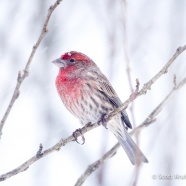Frost Free Frogs?
“The animal kingdom relies on staggering evolutionary innovations to survive winter.” Bernd Heinrich renowned biologist and author – made this statement in his bestselling book entitled “Winter World”. The Wood Frog (Rana sylvatica) is a true embodiment of this statement; these tiny amphibians can survive for weeks with an incredible two-thirds of their body water completely frozen—to the point where they are essentially solid frogsicles! The adaptation that enables this remarkable feat is known as a cryoprotectant – a substance that prevents damage to cells and tissues during...
Read MoreWhy Are Eastern Hemlock Trees Irreplaceable?
Perspective from RTPI’s conservation intern, Heather Zimba I think many people would agree that spending time walking in a forest can be therapeutic, being completely enveloped by the landscape’s vegetation and wildlife. I’ll bet that – if you like the outdoors – you can close your eyes right now and visualize the areas you most like to visit. One of my favorite places is a small gorge that contains a stream with beautiful natural waterfalls. The steep banks of the gorge are lined with deep green evergreen trees that overhang and provide shade along the meandering creek....
Read MoreZombie Fungus?
During a recent Hemlock Woolly Adelgid survey, one of our volunteers found a little yellow blob attached to a hemlock twig. The mass was clearly not HWA, but curiosity prompted me to bring it back to the office for examination. A closer look under the microscope revealed that the blob actually consisted of a powdery fungus encapsulating a dead spider! After a bit of research, I came to suspect that it might be some sort of Cordyceps; a genus of parasitic fungi capable of taking control of an arthropod, thus directing it to navigate to a favorable position for the fungi’s spores to...
Read MoreMale House Finch
Here is a recent photo of a male House Finch (Haemorhous mexicanus) on a snowy afternoon. The beautiful red shades of this guy really stand out against the drab surroundings, and their cheery songs can already be heard here in February on some of the warmer, sunnier days. It is one of the first signs of “spring” as the days began to grow longer. The Purple Finch (Haemorhous purpureus) is a similar species and often confused with the House Finch, especially because both enjoy coming to backyard bird feeders. Roger Tory Peterson described the Purple Finch as having been...
Read MoreSlimy Salamander (Plethodon glutinosus)
There’s always that one subject that is particularly challenging to photograph, and for me it’s the Slimy Salamander. They live in dense forests where the light is quite low and they quickly retreat from bright light, so without a high shutter speed your chances of capturing these secretive salamanders is next to none. What’s more, their jet black body and eyes makes it difficult to get the focus just right. And if you try to move them into a better position, your fingers get coated in their gooey secretions and then you stick to anything else you touch! These elusive...
Read MoreTreasures of the Tropics
In less than two weeks an RTPI crew will be headed to Costa Rica again, this time with students from the Forman School. Students will participate in a variety of research projects, including migratory bird banding and monitoring endangered and recovering amphibian populations, such as this Rufous-eyed Brook Tree Frog (Duellmanohyla rufioculis). Stay tuned for more information soon!
Read More








